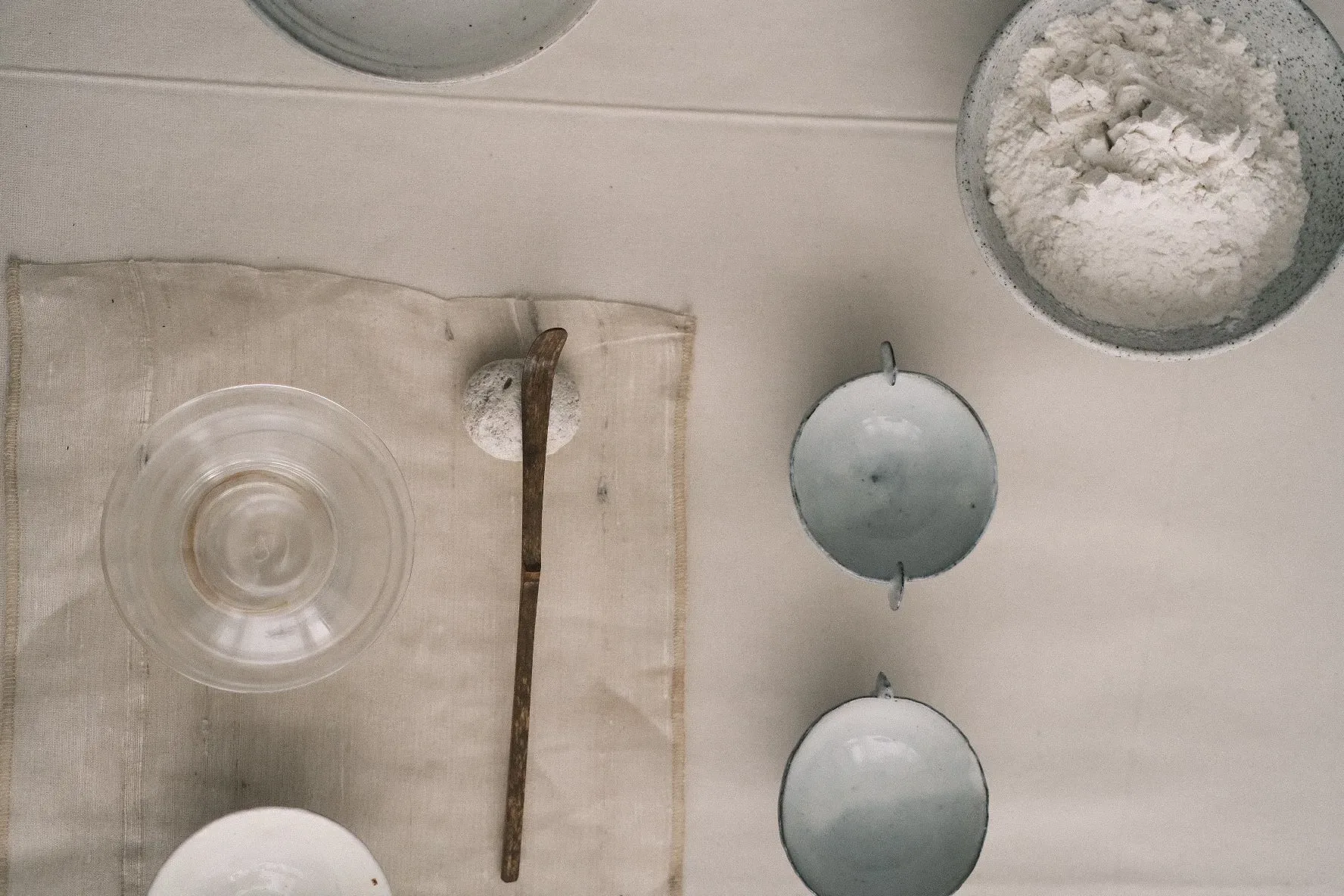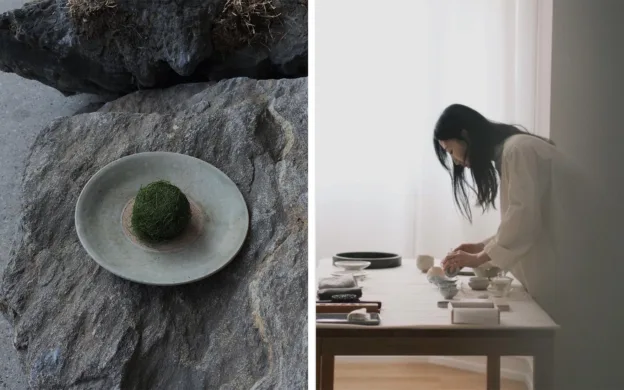Sung Eun, a Korean pastry chef based in Copenhagen, uses her meticulous, edible creates to tell stories inspired by her culture, traditions, and life experiences. She replicates the shapes and texture of nature into her sweets, drawing on years spent refining her pastry techniques and flavors. With Eun’s pastries, every bite is a surprise, introducing to the Danish audience flavor profiles that are close to her heart. Often, her pastries are meant to be paired with tea. Eun notes, “tea making is a meditation; a ritual that can bring you to a calm state.”
Sung Eun is currently writing a book about her life in Denmark. In order to create it, she currently traverses the city with a camera, capturing some of her favorite spots and offering insight into her life.
Over a cup of tea, we spoke with Sung Eun about her background, upcoming book, and, of course, her incredible recipes:
You are originally from Korea and have been living in Denmark for five years now. Now you’re writing a book about life in Denmark for Korean readers. Tell me about coming to Copenhagen and where are you in the process of writing?
While I was visiting Paris, a friend told me about Copenhagen. I didn’t know much about Denmark or its capital but when I arrived, I started learning more. I really liked the city. After that initial visit, I wanted to come back and started looking for a job. I found an internship at Noma; the more I lived here the more I enjoyed being here.
Copenhagen is known for good dining and high-quality pastry. That’s what drives me.
 |  |
As for the book, I write about Denmark and Danish culture as I experience it. I first started writing small stories about my life here in Copenhagen for an online platform, then decided to write a book. There is not much information out there in Korean about Copenhagen but there are so many things I love about this city that I wanted to share with the bigger audience, especially for those who are planning a visit.
In recent years, Nordic culture has become very popular in Korea and there is a big interest in the Scandinavian way of living.
I contacted a Korean publisher, and we thought it was a perfect timing to publish the book. There will be some simple, easy-to-follow Danish recipes, some of my favorite places to visit, including cafes and restaurants, and pictures that I took. The book comes out in February 2024.
Congratulations! Something to look forward to. Speaking of your internship at Noma, can you tell me what you learned there?
One of the best things I learned at Noma was foraging: going out into the wild to get your herbs. At Noma, they grow all the herbs and ingredients on their farm, but they also get them from nature and rediscover varieties of wild Danish ingredients.
At Noma, they take the time and energy to find these herbs all over Denmark and use them in their menu. I still practice foraging. Every time I get something from nature, I preserve it and use it as an ingredient in my creations.

Tell us about your culinary journey to becoming a pastry chef
Back in Korea, I graduated with a degree in food and nutrition. One of the courses was in pastry, including French pastry, and I became really interested in that. I thought: why not discover more about Korean pastry? I am influenced by French technique and Korean traditions.
Something else that inspired my culinary journey was a small café in Korea where I used to go almost every day after university.
There was this lady who made big American cakes and small soups for the guests. She was taking care of all the customers and everything she made was fresh and cozy. That place made me happy. I wanted to make a place like that and share happiness through food.
I should also give credit to my mom and grandmother. They both love cooking, always making big portions and sharing with others. Whenever my mom had spare time she would always cook and call me to try things. I think that helped me a lot in developing my personal tastes.
 |  |
Any plans to open a space of your own?
My husband Ivar and I want to open a tea and sweets space in Copenhagen. I want to introduce good quality teas, with a focus on on Korean tea because they are not widely available in Europe. I have visited several small tea farms in Korea and they have really high quality but have mainly be targeting domestic sales. So we are going to introduce some of the best Korean teas and pair them with sweets inspired by seasonal ingredients.
When it comes to the space itself, I want to create something cozy, where people can drink tea, relax, talk, listen to music, and connect. I am planning to organize gatherings there.
 |  |
I attended one of your gatherings last winter and it was an unforgettable experience. How did the idea of these gatherings come about?
The gatherings are all about bringing people together to seat around the table, drink tea, taste sweets, and strike up conversation. In the beginning, I did gatherings for very small groups but then it grew. In Korea, tea culture is strong and very important when it comes to connecting people.
For me, drinking tea is a habit; compared to other drinks it has the ability to bring people together in an authentic way. Making a cup of tea is a meditation.
One of the gatherings I did at a Tosei ceramic studio was built around the theme of the 24 seasons that are celebrated in Eastern Asia. Every season has a name and there is one called IP-dong, which means getting into the winter. I thought it was meaningful to keep up with the tradition and celebrate it through a cozy gathering.
Apart from the gatherings, you have collaborated with various Danish brands to create delicious and aesthetically pleasing sweets for their events. Tell me about your most recent collaboration and its inspiration
I have recently worked with a Danish knitwear brand called Andersen Andersen, in collaboration with Popeye Magazine from Japan. When thinking about what to prepare, I had in mind that Popeye’s color is green and he loves spinach so I made spinach cakes and several other sweets. They were all green in color but with different flavors. One of the bean sweets was made with matcha while the transparent green jellies were mix of lemon and elderflower.
I like collaborating with many interesting and talented people from various industries. We inspire each other, work together on new projects, and come up with creative ideas together. This is a huge source of inspiration for me, similar to the way that nature inspires me.

Would you like to share a couple of recipes that people could add to their Christmas and New Year menus?
I would love to!
[ Patjuk, 팥죽 ] Winter Red Bean Porridge Recipe
Serves 4
Traditionally we eat Patjuk on Dongji 동지 (winter solstice) which marks the shortest days for the year. Sharing this porridge, we wish our families and neighbors a safe and happy life. When I was young my mom used to make a big pot of Patjuk and shared it with other families.
Red bean porridge is believed to wash away evil spirits during the winter solstice, so people used to sprinkle it on the gate before they eat. Nowadays not many people continue the tradition, but this soup brings us the strength to endure the cold winter.
Ingredients
250g red beans
1.5L water
1 tablespoon white sugar
1/3 teaspoon of salt
For for the rice cake balls:
120g glutinous rice powder
Pinch of salt
30g of sugar
4 tablespoons of hot water
Method
Steps for making the rice cake balls:
![]() Mix rice powder, salt and sugar in a bowl.
Mix rice powder, salt and sugar in a bowl.
![]() Add boiling hot water in the bowl and mix it well.
Add boiling hot water in the bowl and mix it well.
![]() When the dough cools down, knead the dough by hand.
When the dough cools down, knead the dough by hand.
![]() Cut the dough into small pieces and roll it between the palms to make a small ball shape.
Cut the dough into small pieces and roll it between the palms to make a small ball shape.
Steps for making the porridge:
![]() Rinse the red beans.
Rinse the red beans.
![]() Parboil beans for 5 min and discard water.
Parboil beans for 5 min and discard water.
![]() In the pot, add the red beans with water and boil them until they become soft.
In the pot, add the red beans with water and boil them until they become soft.
![]() Turn off heat from the beans and let the beens cool down.
Turn off heat from the beans and let the beens cool down.
![]() Purée the beans with the liquid until smooth. Adjust the thickness of the puree by adding more water.
Purée the beans with the liquid until smooth. Adjust the thickness of the puree by adding more water.
![]() Put the purée in the pot and add salt and sugar.
Put the purée in the pot and add salt and sugar.
![]() Put the rice cake balls in the purée and cook until it floats.
Put the rice cake balls in the purée and cook until it floats.
![]() Add sugar, honey or cinnamon to the Patjuk to your tastes. Enjoy!
Add sugar, honey or cinnamon to the Patjuk to your tastes. Enjoy!
Find out more about Sung Eun.

